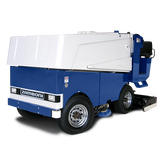I found this post a few years ago on the USA Broomball Site. It is probably the best explanation of preparing ice for broomball that I have found.
How to Zamboni the ice
Interview with the Minnesota Zamboni Yoda, Paul Haglund!
The trick is to use just enough water to find the balance between "greasy" and "tackified" ice. Broomball players need it to be right in the middle of those two extremes. The general rule is to use 1/3 wash water and 1/4 to 1/3 ice-making water. You will know you've got it right when you see the ice is already setting up by your second pass. When making a regular wet cut for hockey, you likely see 2" to 4" of water coming from the conditioner holes. However, for Broomball ice, you should see only about 3/4" to 1" coming out instead.
Here are some of the finer points:
Depending on how the ice was used prior to broomball play, you should adjust how much you are cutting the ice. If you had an aggressive adult league, you should cut deeper. If you just had a bunch of kids, cut lightly with less or no water.
After an evening of Broomball, about 8 games or so, you should definitely "edge out" the ice to keep the bits of dirt from broomball shoes becoming a permanent part of the ice (discoloration).
During a longer tournament, you will want to run the Zamboni with very little wash and ice-making water, while just barely cutting the ice. The reason for this, is depending on the temperature and humidity, ice will tend to become more "tackified", so you want to keep it slightly "greasy" but not too much.
There was an additional clarification I found...
One follow up question… Our rink does a cold cut. I assume they do this so that the water sets up faster. Should we do a cold cut or use regular (warm water) cut when following the below instructions.
(Paul replied) - Just to clarify the points and answer the question below, as a rule of thumb, the amounts of water used below (about 1/3 wash water and 1/4-1/3 ice water) should be used whenever making broomball ice. How much you use depends on how your individual ice surface reacts to the amount laid down. Typically, in my experience, you should be laying a little less water if it’s warmer (air and ice temps) and a little more if colder. I’m talking only slightly more or less. Determining the right amount of water to lay takes only to watch the action on ice after you have made the ice. If it’s too tacky, lay a little more water, too greasy or slick, lay less.
If time allows after the ice has been cut quite heavily from a previous user, dry shave (no water) first, then make your broomball ice afterward. Deep gouges in your ice are enemies of broomball shoes and will lessen the quality of your surface to your users. If the ice isn’t too cut up, you can just cut the ice deep enough to get the light skate cuts out while laying your broomball amount of water.
Edge after tourneys or long periods of brooms to get the dirt out of the ice. If you don’t, you’ll have very dirty ice along the boards, which aesthetically takes away from your product and is an enemy to skates.
You’ll need to freshen the ice during a long broomball day, every 6-8 hours, depending upon how tackified the ice gets. As the dirt builds up throughout the games, your ice will get extremely sticky. Take a break in the games and skim the top of the ice with the zam while laying normal broomball water.
There is no need to lay cold water. I always use hot water and if your ice is not setting up by your next pass, your probably using too much water anyway.

